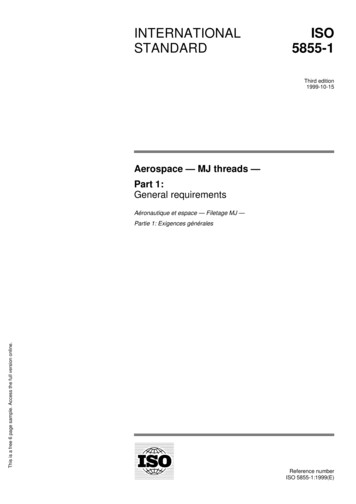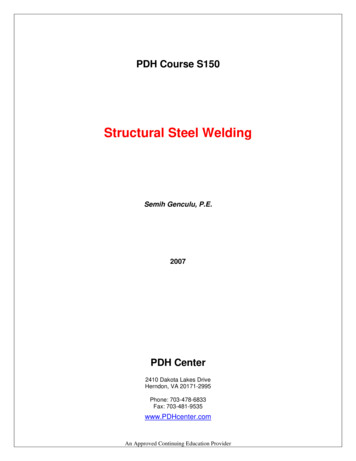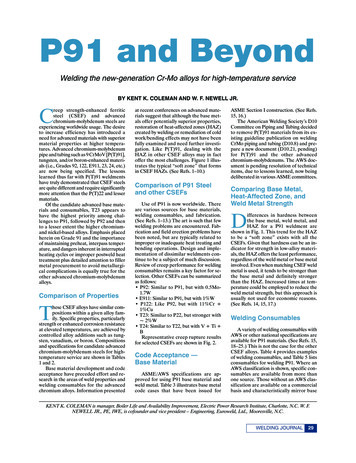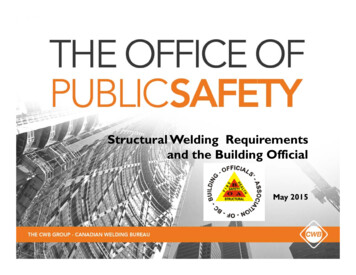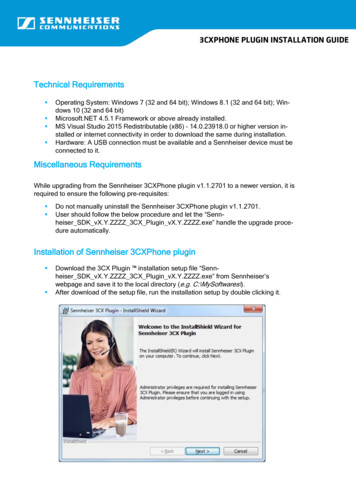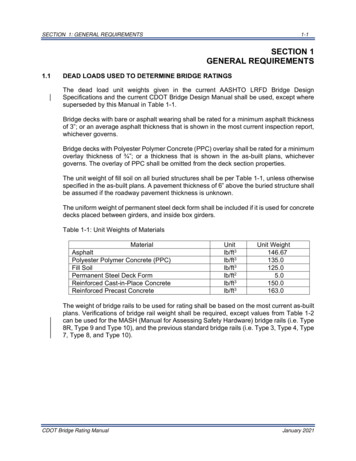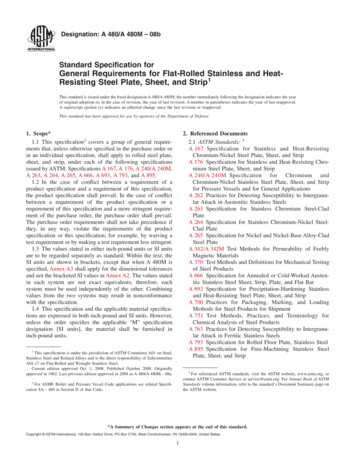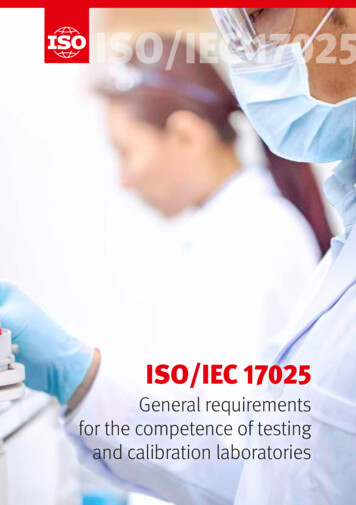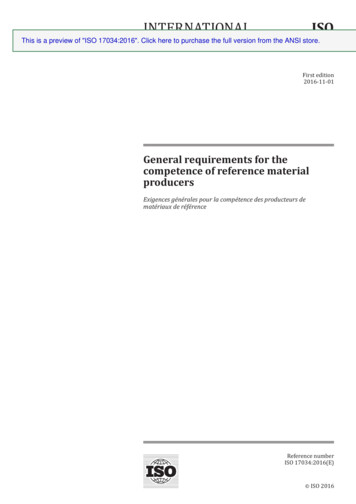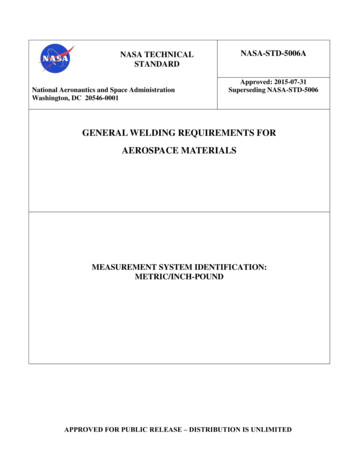
Transcription
NASA-STD-5006ANASA TECHNICALSTANDARDNational Aeronautics and Space AdministrationWashington, DC 20546-0001Approved: 2015-07-31Superseding NASA-STD-5006GENERAL WELDING REQUIREMENTS FORAEROSPACE MATERIALSMEASUREMENT SYSTEM IDENTIFICATION:METRIC/INCH-POUNDAPPROVED FOR PUBLIC RELEASE – DISTRIBUTION IS UNLIMITED
NASA-STD-5006ADOCUMENT HISTORY LOGStatusDocumentRevisionBaselineRevisionAApproval DateDescription1999-02-17Baseline Release2015-07-31General RevisionAPPROVED FOR PUBLIC RELEASE – DISTRIBUTION IS UNLIMITED2 of 33
NASA-STD-5006AFOREWORDThis Standard is published by the National Aeronautics and Space Administration (NASA) toprovide uniform engineering and technical requirements for processes, procedures, practices, andmethods that have been endorsed as standard for NASA programs and projects, includingrequirements for selection, application, and design criteria of an item.This Standard is approved for use by NASA Headquarters and all NASA Centers, includingComponent Facilities and Technical and Service Support Centers.This Standard establishes general directions and describes the type of information that NASAexpects for welded structures. This Standard does not provide the detailed process and qualityassurance requirements for weldments on flight hardware. Instead, it is intended as a higherlevel document which states minimum requirements for welded hardware.“Requests for information, corrections, or additions to this Standard should be submitted via“Feedback” at http://standards.nasa.gov.”Original Signed By:2015-07-31Ralph R. Roe, Jr.NASA Chief EngineerApproval DateAPPROVED FOR PUBLIC RELEASE – DISTRIBUTION IS UNLIMITED3 of 33
NASA-STD-5006ATABLE OF CONTENTSSECTIONPAGEDOCUMENT HISTORY LOG .FOREWORD .TABLE OF CONTENTS .LIST OF APPENDICES .LIST OF FIGURES .234551.1.11.21.3SCOPE . 6Purpose . 6Applicability.6Tailoring .62.2.12.22.32.4APPLICABLE DOCUMENTS . 7General . 7Government Documents. 7Non-Government Documents . 7Order of Precedence . 73.3.13.2ACRONYMS AND DEFINITIONS . 8Acronyms and Abbreviations. 8Definitions . ENTS .12Specification of this Standard on Contracts .12Joint Classes .12Equipment .13Materials .14Weld Procedure and Performance Qualification.16Pre-Weld Operations .18Production Welding .19Post-Weld Operations .21Weld Joint Strength Requirements.25Weldment Quality Requirements .26Repair Welding .26Quality Assurance .27APPROVED FOR PUBLIC RELEASE – DISTRIBUTION IS UNLIMITED4 of 33
NASA-STD-5006ATABLE OF CONTENTS uidance .Purpose .Reference Documents .Government Documents .Non-Government Documents.303630303032LIST OF FIGURESFIGURE12345PAGEWelding Procedure Specification Example .Welding Techniques .Mismatch and Peaking .Fillet Welds .Minimum Inspection Requirements .1720222429APPROVED FOR PUBLIC RELEASE – DISTRIBUTION IS UNLIMITED5 of 33
NASA-STD-5006AGENERAL WELDING REQUIREMENTS FORAEROSPACE MATERIALS1.SCOPE1.1PurposeThe purpose of this Standard, as defined in NASA Procedural Requirement (NPR) 7120.10,Technical Standards for NASA Programs and Projects, is to establish the processing and qualityassurance requirements for manual, automatic, machine, and semiautomatic welding forspaceflight applications and special test equipment used for testing flight hardware with theexception of ground-based pressure systems, which are subjected to NASA-STD-8719.17,NASA Requirements for Ground-Based Pressure Vessels and Pressurized Systems (PVS).1.2ApplicabilityThis Standard is applicable to all welding processes used for joining metallic materials. Thisincludes, but is not limited to arc welding (AW), solid state welding (SSW), resistance welding(RW), and high energy density welding (HEDW). This Standard covers all metallic materialsused in the manufacture of hardware for spaceflight applications and special test equipment usedfor testing flight within NASA.This Standard is approved for use by NASA Headquarters and NASA Centers, includingComponent Facilities and Technical and Service Support Centers, and may be cited in contract,program, and other Agency documents as a technical requirement. This Standard may also apply tothe Jet Propulsion Laboratory or to other contractors, grant recipients, or parties to agreements onlyto the extent specified or referenced in their contracts, grants, or agreements.Requirements are numbered and indicated by the word “shall.” Explanatory or guidance text isindicated in italics beginning in section 4.1.3TailoringTailoring of this Standard for application to a specific program or project shall be formallydocumented as part of program or project requirements and approved by the responsibleTechnical Authority in accordance with NPR 7120.5, NASA Space Flight Program and ProjectManagement Requirements. The requirements in this document may be tailored by submitting adetailed weld process specification or stating applicable industry standards that meet the intent ofthis Standard.APPROVED FOR PUBLIC RELEASE – DISTRIBUTION IS UNLIMITED6 of 33
NASA-STD-5006A2.APPLICABLE DOCUMENTS2.1GeneralThe documents listed in this section contain provisions that constitute requirements of this Standardas cited in the text.2.1.1 The latest issuances of cited documents shall apply unless specific versions are designated.2.1.2 Non-use of specific versions as designated shall be approved by the responsible TechnicalAuthority.The applicable documents are accessible at https://standards.nasa.gov or may be obtaineddirectly from the Standards Developing Organizations or other document distributors.2.2Government DocumentsNASA2.3NPR 1441.1NASA Records Management Program RequirementsNPR 7120.5NASA Space Flight Program Management RequirementsNPR 7120.10Technical Standards for NASA Programs and ProjectsNon-Government DocumentsAerospace Industries Association (AIA)/National Aerospace Standard (NAS)AIA/NAS 410NAS Certification and Qualification of Nondestructive TestPersonnelAmerican Welding Society (AWS)AWS QC12.4Standard for AWS Certification of Welding InspectorsOrder of Precedence2.4.1 This Standard establishes requirements for all welding processes used for joiningspaceflight metallic materials but does not supersede nor waive established Agency requirementsfound in other documentation.APPROVED FOR PUBLIC RELEASE – DISTRIBUTION IS UNLIMITED7 of 33
NASA-STD-5006A2.4.2 Conflicts between this Standard and other requirements documents shall be resolved bythe responsible Technical Authority.3.ACRONYMS AND DEFINITIONS3.1Acronyms and Aerospace Industries AssociationAerospace Material SpecificationAmerican Society of Mechanical EngineersAmerican Society for Testing Materialsarc weldingAmerican Welding Societyfriction stir weldinghigh energy density weldingJohnson Space CentermilitaryMarshall Procedural RequirementsMaterial Review BoardMarshall Space Flight CenterNational Aerospace StandardNational Aeronautics and Space Administrationnondestructive evaluationNASA Procedural Requirementspressure vessels and pressurized systemsProcedure Qualification RecordQuality AssuranceStandard for AWS Certification of Welding Inspectorsresistance weldingSafety and Mission AssuranceSociety of Automotive Engineerssolid state weldingstandardWelding Procedure SpecificationDefinitionsAutomatic Welding: A welding operation performed without adjustment of the controlsby a welding operator.Certified: With respect to a welder, means a welder or inspector who has passedqualification tests based on requirements established in this Standard. With respect to aAPPROVED FOR PUBLIC RELEASE – DISTRIBUTION IS UNLIMITED8 of 33
NASA-STD-5006Aprocedure or process specification, a term describing a weld procedure or process that has passedqualification tests based on requirements established in this Standard.Concave Root Surface: A weld root with penetration not extending beyond the thicknessof the parent metal. Note: Periodically referred to as “suckback.”Conventional Friction Stir Welding (FSW): FSW in which the load is reacted by ananvil.Critical Flaw Size: The analytically determined flaw size that produces a critical stressintensity factor of concern for a specified number of life cycles which will likely produce acatastrophic mission failure.Defect: A discontinuity or discontinuities that by nature, or accumulated effect, rendera part or product unable to meet minimum standards or specifications; designates rejectability.Dross: A mass of solid impurities floating on a molten metal or dispersed in the metal.Essential Variables: Weld process parameters that influence directly the weld processand resulting weld properties in such a manner that changes to them require requalification of theweld procedure. Note: Examples are heat input, travel speed, torch setup, and pin toolconfiguration.Fail Safe: A condition in which, after failure of a single individual structural member,the remaining structure can withstand the redistributed loads with an ultimate factor of safetyof 1.0 on limit load. Note: The failure is contained or constrained so that the failed part doesnot affect other flight elements or personnel.Heat-Affected Zone: The portion of the base metal whose microstructure ormechanical properties have been altered by the heat of welding, brazing, soldering, or thermalcutting.Heat Input: Quantity of energy introduced per unit length of weld from a traveling heatsource, expressed in joules per millimeter or joules per inch. Note: Computed as the ratio of thetotal input power of the heat source in watts to the travel velocity in millimeters persecond or inches per minute.Heat Sensitive Alloys: Alloys that require mechanical working, precipitationstrengthening, or other metallurgical mechanisms to regain their rated strength due to exposure tothe heat input from the welding process.Improper Fusion: A condition when the weld metal that replaces base metal isinsufficient.APPROVED FOR PUBLIC RELEASE – DISTRIBUTION IS UNLIMITED9 of 33
NASA-STD-5006AIncomplete Fusion: A weld discontinuity in which fusion did not occur between weldmetal and parent material or adjoining weld beads.Incomplete Joint Penetration: The condition of a weld failing to extend through the fullthickness of the joint.In-Process Correction: Action taken by a welder to co
Machine Welding: Welding with equipment that performs the welding operation under the constant observation and control of a welding operator. Manual Welding: A welding operation performed and controlled completely by hand. Material Review Board (MRB): A cross-functional group that reviews production or purchased items on hold because of nonconformance or usability concerns. The MRB is
